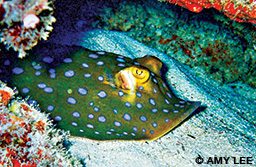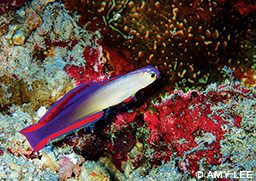It was Oct. 31, Halloween, and I was ready and waiting with my mask on. Gripping my survey slate and camera, I eagerly backrolled off the boat. Technicolor schools of fish surrounded me as I descended along a steep wall. Bluestreak fusilier and scalefin anthias mixed with bignose unicornfish and yellowfin surgeonfish, and I quickly grabbed my pencil to record all of these species. The rush of excitement I felt as I checked off each one was reminiscent of the thrill I felt while trick-or-treating as a kid and trying to collect as much Halloween candy as possible.
I glanced at my dive buddy, who clutched her slate, busily jotting down information as more fish materialized each second. Along with eight other divers, we were part of a team of volunteers mobilized by Reef Environmental Education Foundation (REEF), a marine conservation organization whose mission is to protect biodiversity and ocean life by engaging and inspiring the public through citizen science, education and partnerships with the scientific community. I was the lucky REEF staff member who had the opportunity to lead this group of divers on a field survey trip to the Solomon Islands. For nine days we explored the waters of Marovo Lagoon to record as many different fish species as possible in REEF’s citizen science database.

The REEF Volunteer Fish Survey Project represents the world’s largest database of marine-life sightings, containing more than 250,000 surveys to date. Divers and snorkelers of all ages and experience levels and from all over the world — from warm, tropical waters to cold and temperate regions — conduct REEF surveys. Because REEF collects data from all over the world, it’s possible for divers to survey nearly anywhere there is salt water, from the Solomon Islands to the Pacific Northwest. REEF volunteers in temperate regions also collect data on key invertebrate and algae species. More than 15,000 volunteers have contributed at least one survey to REEF’s database.
It took 38 hours, four flights, one overnight stay in Australia and a rain-drenched boat ride for me to get from my home in Florida to Uepi Island in the Solomons. Uepi is a small barrier island covered in coconut palms and a lush rainforest, surrounded by a fringing reef and a sandy beach. One of the most amazing parts of the island was a steep drop-off visible from the dive dock, which made the reefs easily accessible for snorkeling during surface intervals.

Our first dive in the Solomon Islands was at Uepi Point. An almost-vertical corner formed the point, which jutted out in open water and dropped thousands of feet below the ocean’s surface. Depending on the tides and currents, hundreds of pelagic species such as barracudas and jacks would congregate at the point to hunt and feed. A gently flowing current allowed us to drift through the shallow coral garden surrounding the island, which was teeming with plenty of damselfish, butterflyfish and parrotfish. With the right conditions it was possible to ride the current from the action-packed point back to the shallows of the dive dock. The dive profile, gorgeous conditions and astounding fish diversity made Uepi Point a fish surveyor’s paradise, and we made many dives there throughout the trip.
One day, after what felt like a particularly productive dive at Uepi Point, I decided to count how many species I had recorded. I was hoping to break 200, which is considered a lot for one survey in the tropical Pacific. I was shocked to discover that I had recorded nearly 300 different fish species on a single survey. Several other divers in our group recorded personal bests on Uepi Point as well.

After a few days some of us were longing for a muck dive, and we asked if there were any suitable silty mangrove locations we could explore. Many dive operators consider this an absurd question; I’ve lost count of the number of times I’ve heard, “But there aren’t any fish over there,” after someone has excitedly pointed out a seagrass bed or a surge-covered iron shore area. It’s true that the fish diversity on a reef site far exceeds that of other habitats, but places such as mangroves, seagrass and sandy bottoms come to life when seen through the eyes of a fish surveyor.
Diving in an alternative habitat provides an excellent opportunity to find species such as seahorses, shrimp gobies and jawfish that are less frequently seen. Additionally, lots of juvenile fish and sharks hide in mangrove nurseries until they are big enough to fend for themselves on the reef. REEF surveyors usually jump at the chance to visit an unusual dive site because it is an opportunity to record more species on our lifetime list of sightings.

To our delight, the dive staff at Uepi was very accommodating. They took some of us to mangrove channels on the opposite side of the island, while others in our group visited a reef. Even though the visibility was less than 5 feet, we spent nearly two hours exploring the silt and sand. We ultimately found several new species for our master sightings list, which currently totals more than 760 species.
Volunteers use a data-entry program to submit their surveys to REEF. After going through an error-checking process, the data are then added to REEF’s publicly accessible online database.

Scientists, researchers, policymakers and resource managers use REEF data to conduct research and make informed management decisions. Recreational divers and snorkelers can learn what marine life to look for on a dive by consulting the database to find what species have been reported at a given location. After each field survey trip, REEF generates a report of all the species that the surveyors recorded throughout the trip. Reports from all trips, including the Solomon Islands trip, are available online.
By engaging in a meaningful ocean citizen science initiative such as the Volunteer Fish Survey Project, each dive is an opportunity to continue a fascinating and rewarding underwater scavenger hunt. To get involved, visit REEF.org.
Explore More
Watch this video to learn more about the REEF volunteer fish survey.
© Alert Diver — Q2 2020